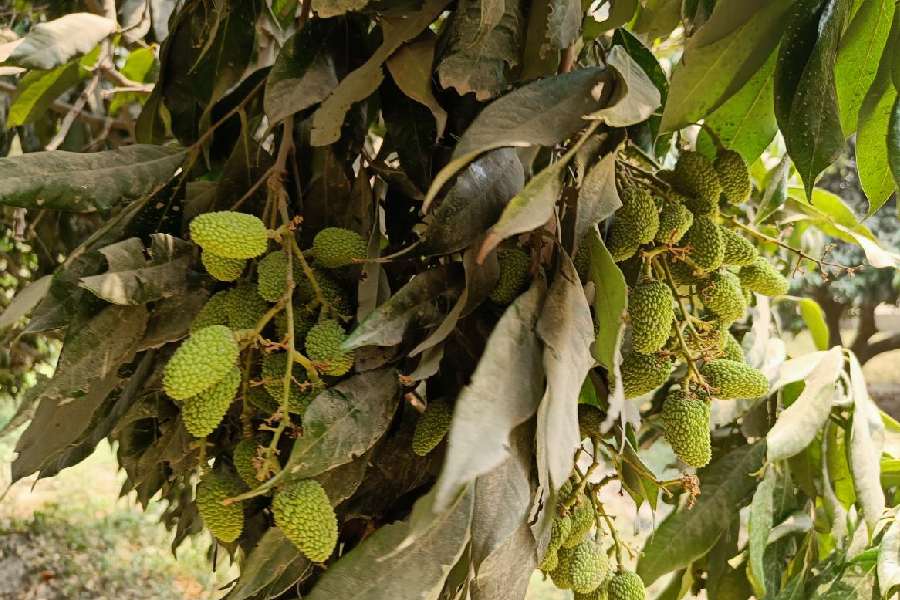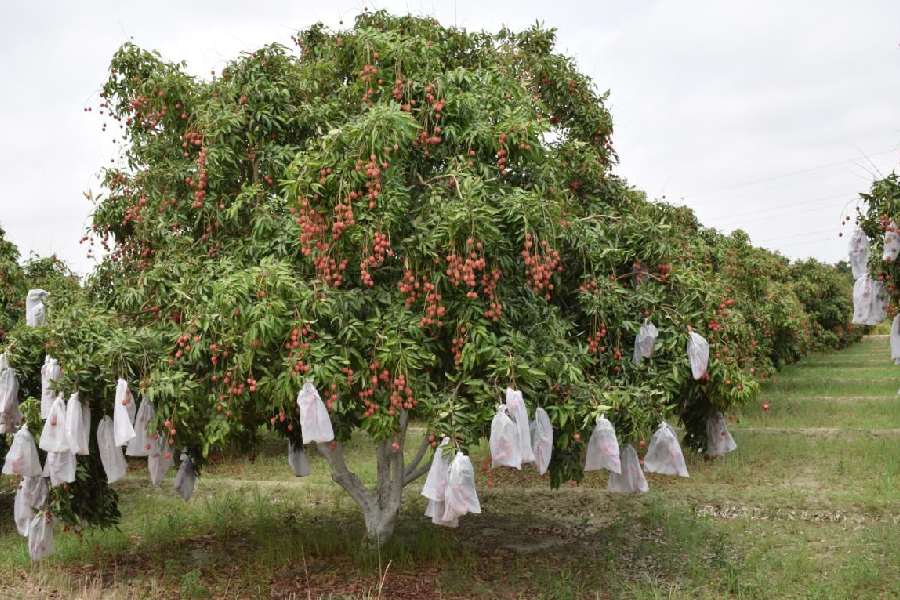The “litchi seat” of Bihar is in distress these days. The yield of the special summer fruit is estimated to drop by around 50 per cent due to the vagaries of nature.
The bad luck and trouble have left farmers in Muzaffarpur sad, scared and seething and it may spill into the elections, as the plucking of litchis will coincide with the polling date — May 20.
All 26 candidates in the fray here, especially the main ones — BJP’s Raj Bhushan Choudhary and Congress’s Ajay Nishad — are keeping their fingers crossed on what the farmers’ anger may bring to the electoral platter.
Muzaffarpur is the only place where GI (Geographical Indication) tag ‘Shahi litchis’ — known for their sweetness, subtle rosy fragrance, taste, extra juicy pulp and small seed — are grown. The fruit has fans across the globe.

Stunted litchis in Muzaffarpur this season. Dev Raj
Deep furrows line the foreheads of the cultivators at a time when everyone should have been discussing the ongoing elections. Litchi is a cash crop for them, providing extra bucks amid the farming of foodgrains.
“The abnormal heat this April has taken a toll. A huge chunk of the fruits dropped and those that survived have become stunted. I had plans to supply the fruits to Patna and use the money to buy a motorcycle but it will have to be postponed. The problem is that we have to do everything on our own. No government supports us and we have to fend for ourselves,” says Pramod Kumar, sitting with his friend Lalo Paswan, at his litchi orchard at Kanti in the constituency.
Litchi is cultivated on 98,000 hectares of land in India with the annual production touching around 7 lakh tonnes. Bihar grows litchi on 34,000 hectares, producing around 2.8 lakh tonnes or 40 per cent of the country’s output, and most of it is done in and around Muzaffarpur.
The distress at the litchi production hub is widespread.
Bhola Nath Jha, a top litchi producer of Muzaffarpur, who was once instrumental behind the now defunct Litchi Growers’ Association of Bihar, asserts that the state and central governments have not done anything for those who are cultivating the fruit.
“We had sent 200 tonnes of litchi to the European Union in 2000, facilitated by the Centre. But things have deteriorated since then. We do not get logistics support, freight subsidy, and air cargo arrangements now,” Jha says.
“We are still using decades-old export technology, which helps give a shelf life of 15 days. There are new technologies available to increase the shelf life to 30 days, but the government has paid no attention. The GI tag is of no help if we cannot brand the litchis and send them quickly to different countries,” Jha adds.
Prime Minister Narendra Modi, at an election rally in Muzaffarpur earlier this week, mentioned facilitating the GI tag for Shahi litchis. His comment has come under criticism from the farmers, who pointed out that such tags were useless unless the government facilitated forward and backward linkages.
They also asserted that the middlemen exploit them because there is no proper ‘mandi’ or ‘bazaar samiti’ or markets in Bihar since chief minister Nitish Kumar repealed the Agricultural Produce Market Committee Act in 2006. Though the state government has announced the revival of bazaar samitis, it is yet to be executed.
The National Research Centre on Litchi, established by the Union government in 2001, is trying to address the various issues pertaining to the fruit and its cultivation.
“Botanically, our scientists are doing much work. But one thing is starkly noticeable and worrisome. A good litchi tree on an average yields two quintals (200kg) of fruits in a season. The middlemen hire a tree for around ₹2,500 in Bihar, so the farmers here get ₹12-13 per kg. However, such trees are hired for around ₹7,000-8,000 in Bengal and other states, with the farmers getting ₹35-40 for a kg,” Bikash Das, director
of the research centre, told The Telegraph.
“This is exploitation of Bihar’s farmers, especially when their produce, especially the Shahi litchis, are top notch. Somebody should address this issue. The cultivators should get a larger share of the money to survive in this field. Direct trains to markets, sufficient air cargo space, and a comprehensive market system should be developed. The farmers also need to be strong,” Das added.
Scientists at the centre estimate litchi production in Bihar this year to be around 1.4 lakh tonnes against 2023’s 2.8 lakh tonnes.
With the elections being held amid this scenario, people are lambasting the two main candidates, Nishad and Choudhary.
Two-time BJP MP from Muzaffarpur Nishad switched over to the Congress after being denied a ticket. His father Jai Narain Prasad Nishad had won the seat four times.
“Ajay Nishad did not do anything during his 10 years as MP. He is now with the Congress. His father also did not do anything much for Muzaffarpur. Can we
expect anything new from him? On the other hand, when the previous BJP MP did not do anything for the constituency, how can we believe that the new contestant will do anything?” said RTI activist and farmer Hemant Kumar.
Hemant also pointed out that Prime Minister Modi’s rally in Muzaffarpur did not attract a crowd like the ones in 2014 and 2019.
“Moreover, the venue of the rally was the airport ground at Patahi on the outskirts of the town. This airport was functional till 1971-72. Modi, while addressing a rally at the same venue in 2014, had promised its revival. But nothing has been done so far. People felt that holding the rally at the same place was shameful and a blunder on the BJP’s part. It has sent a bad signal among the masses,” Hemant added.
Muzaffarpur votes on May 20










